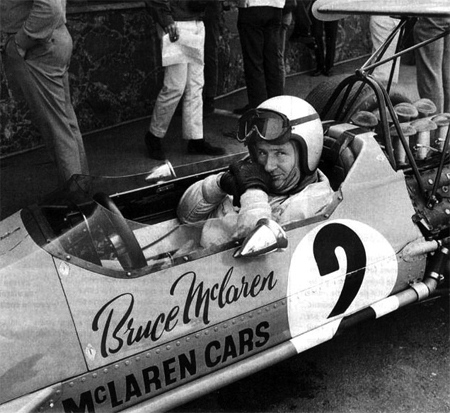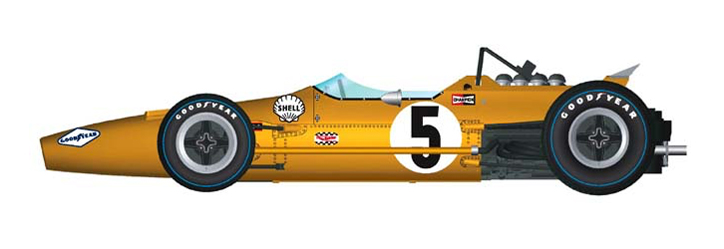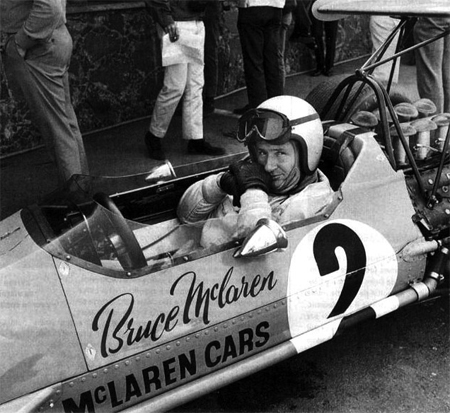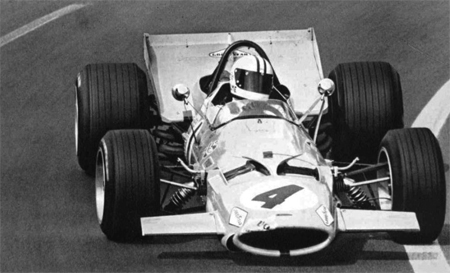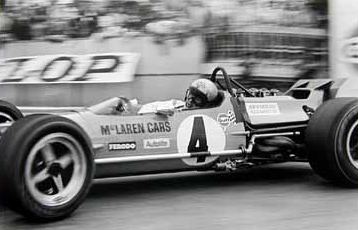McLaren M7A
Car: McLaren M7A / Engine: V-8 Ford-Cosworth / Maker: McLaren / Bore X Stroke: 85.7 mm X 64.8 mm / Year: 1968 / Capacity: 2,993 cc / 182.5 cu in / Class: Formula 1 / Power: 415 bhp at 9,500 rpm / Wheelbase: 94 inches / Track: 58 in front and 57 in the rear / Weight: 1140 lbs / Wheels: McLaren’s own magnesium alloy wheels were used; they were 15-inch (380 mm) diameter at the rear and 15- or sometimes 13-inch (330 mm) diameter at the front.
In 1967 Cosworth debuted the legendary DFV engine which in the first year was supplied exclusively to the Lotus team. It was immediately successful, winning its first race, and for 1968 it became available for purchase by any manufacturer.
That year saw the introduction of the Mclaren M7A. It would be McLaren’s first Ford Cosworth DFV—powered race car and Robin Herd would create a straight forward design around a three-quarter length monocoque, following Lotus’s lead in using the V8 as a structural element. Transmission was provided by a standard Hewland DGSOO five-speed transaxle. The suspension was conventional and derived from the M6A’s, via outboard coil spring/dampers units both ends and single lateral links and trailing arms at the front and single lateral top links, reversed lower wishbones and twin radius rods at the rear. Lockheed brakes would provide the stopping power along with tires from Goodyear. Herd began the design of the M7A towards the end of 1967 but left to join Cosworth before its completion, leaving Coppuck and Bruce McLaren to complete the work.
The car would win the first two non-championship races at the beginning of the year and the future looked bright. A second and two fifth place finishes by Hulme went some way towards offsetting the disapointment of Bruce McLaren’s three retirements. At Spa Bruce McLaren became the second driver to win a championsahip event with a car of his own manufacture after Brabham.
After a midseason dip Hulme would score two additional victories for Mclaren in Italy and Canada but eight retirements wopuld allow Lous to claim another Constructor’s Championship and graham Hill the title.
For 1969 McLaren, a new four-wheel drive car, the M9A, but while that was being readied, continued with the old car. The M9A was eventually unsuccessful and appeared only once, driven by Derek Bell at the British Grand Prix. McLaren would have to soldier on with the older car. Two different versions did emerge; the M7B with pontoon mounted fuel tanks and a brand new M7C, which featured a F5000 derived fully-enclosed monocoque.The cars would appear with both high rear and front wings but thankfully these were banned by the CSI. Denis Hulme would score a last win at the season ending race in Mexico droiving a M7C. Jo Bonnier drivingdriving for his own team would continue to field a McLaren M7C through the 1971 season. Coupled with their success in the CanAm series and in the future at Indianapolis McLaren would be firmly established in the front ranks of racing car teams.


